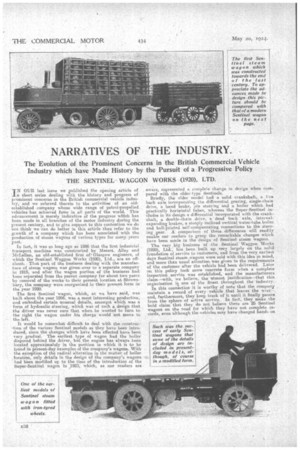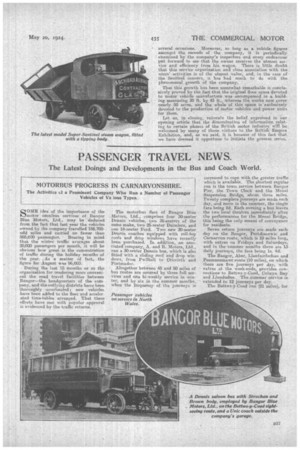NARRATIVES OF THE INDUSTRY.
Page 20

Page 21

If you've noticed an error in this article please click here to report it so we can fix it.
The Evolution of the Prominent Concerns in the British Commercial Vehicle industry which have Made History by the Pursuit of a Progressive Policy
THE SENTINELWAGGON WORKS (1920), LTD.
TN OUR last issue we published the opening article of a short series dealing with the history and progress of prominent concerns in the British commercial vehicle industry, and we referred therein to the activities of an oldestablished company whose wide range of petrol-propelled vehicles:has achieved fame in all parts of the world. This advancement, is merely indicative of the progress which has i been made in all branches of the motor ndustry during the present century, and to give support to this contention we do not think we can do better in this article than refer to the growth of a company which has been associated with the production of steam wagons of Various types for many years past.
In fact, it was so long ago as 1896 that the first industrial transport machine was constructed by Messrs. Alley and McLellan, an old-established firm of alas gow engineers, of which the Sentinel Waggon Works (1920), Ltd., are an offshoot. That part of the business dealing with the manufacture. of steam wagons was given over to a separate company in 1915, and after the wagon portion of the business had been separated from the parent company for about two years by removal of the works.to their present location at Shrewsbury, the company were reorganized in their present form in the year 1920.
The first Sentinel wagon, which, as we have said, was built about the year 1806, was a most interesting production, and embodied certain unusual details, amongst which was a form of hydraulic steering, which was of such a design that the driver was never sure that when he wanted to turn to the right the wagon under his charge would not move to the left.
It would be. somewhat difficult to deal with theconstruestion of the various Sentinel models as they have been introduced, since the changes which have been effected have been very gradual. The earliest type of wagon had the boiler disposed behind the driver, but the engine has always been located approximately in the position in which it is to be found in present-day examples of the company's wagons. With the exception of the radical alteration in the matter of boiler location, only details in the design of the company's wagons had been modified up to the time of the introduction of the Super-Sentinel wagon in ,I923, Whieh, as onr readers are
aware, represented a complete change in design when cons, pared with the older-type Sentinels.
Briefly, the alder model had a solid crankshaft, a live back axle incorporating the differential gearing, single-chain drive, a band brake, pin steering and a boiler which had practically horizental tubes, whereas the Super-Sentinel includes in its 'design a differential incorporated with the crankshaft, a double-chain drive, a dead back' axle internalexpanding brakes, a steeply inclined vertical water-take boiler and ball-jointed self-compensating connections to the Steering. gear. Acomparison of these differences will readily enable our readers to grasp the remarkable changes which have been made in the design of Sentinel steam wagons.
The very big business of the Sentinel Waggon Works (1920), Ltd. has been built up very largely on the solid: foundation of service to customers, and from the very earliest . days Sentinel steam wagons were sold *Jai this idea in mind, and more than usual attention, was given to the requirements of the customer after the vehicle had been delitered. Later on this policy took more. concrete form when a complete inspection service was established, and the manufacturers claim—with, we believe, the utmost justification—that thii organization i one of the finest throughout the industry..
In this connection it is worthy of note that the company , maintain a record 'of every vehicle that leaves the wont:.... and, furthermore, they keep track of it until it finally passes from the sphere of active Service. In fact, they make the bold claim that they do not believe there are 25 Sentinel wagons on the road for which they have not complete records, even although the vehicles may have changed hands on several occasions. Moreover, so long as a vehicle figures amongst the records of the company, it is periodically teramined by the company's inspectors and every endeavour put forward to see that the owner receives the utmost service and efficiency irOn" his wagon. There is little doubt . that this service organization and close association with the users' activities is of the utmost 'value, and, in the case of the Sentinel concern, -it has had much to do with the phenomenal growth of the company.
That this growth has been somewhat remarkable is conch' . . sively proved by the fact that the original floor space devoted to motor vehicle mannfacture was encompassed ina building measuring 30 ft. by 45 ft., whereas the works now cover nearly 50 acres, and the whole of this space is 'exclusively devoted to the production of motor vehicles and power units for them.
Let us, in closing, reiterate the belief expressed in our , opening article that the dissemination of informationrelating to certain phases of the British motor industry. will 'be: welcomed by many of those visitors to the British -Empire Exhibition, a.nd, as we said, it is because of this fact that • we have deemed it opportune to initiate the present series.






























